#creating an online marketplace
Explore tagged Tumblr posts
Text
How to Create an Online Marketplace
Want to creating an online marketplace? This guide covers everything you need to know, from planning and building your platform to attracting sellers and buyers. Learn the key steps to turn your idea into a successful online business. Perfect for entrepreneurs looking to enter the e-commerce world.

#start an online marketplace#creating an online marketplace#start a marketplace website#how to create a marketplace website#create online marketplace#create a marketplace website
0 notes
Text
HOW TO LEARN DIGITAL MARKETING.

Many of your clients will be looking for content they can use on social media. Although there are types of content they can use across multiple channels, some need to be designed specifically for social media use.
2 notes
·
View notes
Text
5 BUSINESSES YOU CAN START TODAY - MAKE MONEY ONLINE -
>> follow @lavishleaders >> follow @lavishleaders >> follow @lavishleaders
Selling goods or services online: Setting up an e-commerce store or using an online marketplace such as Amazon, Etsy, or eBay to sell goods or services can be a great way to make money online.
Online affiliate marketing: Partnering with other businesses to promote their products or services and earning a commission for each sale made through a unique referral link.
Online tutoring or consulting: Offer your expertise in a specific subject or field and provide online tutoring or consulting services.
Online content creation: Create and monetize online content such as videos, podcasts, or blog posts through advertising, sponsorships, or merchandise sales.
Online trading or investing: Investing in stocks, cryptocurrency, or other online investment opportunities can provide a significant return on investment.
#5 BUSINESSES YOU CAN START TODAY - MAKE MONEY ONLINE -#>> follow @lavishleaders#Selling goods or services online: Setting up an e-commerce store or using an online marketplace such as Amazon#Etsy#or eBay to sell goods or services can be a great way to make money online.#Online affiliate marketing: Partnering with other businesses to promote their products or services and earning a commission for each sale m#Online tutoring or consulting: Offer your expertise in a specific subject or field and provide online tutoring or consulting services.#Online content creation: Create and monetize online content such as videos#podcasts#or blog posts through advertising#sponsorships#or merchandise sales.#Online trading or investing: Investing in stocks#cryptocurrency#or other online investment opportunities can provide a significant return on investment.#millionaire#onlinebusiness#successful#lavishleaders#onlineshopping#business#entrepreneur#digitalmarketing#onlinestore#onlinemarketing#smallbusiness#onlineshop#marketing#online#businessowner
3 notes
·
View notes
Text
Sell Your Old Laptop in Bangalore for Instant Cash
Selling your old laptop in Bangalore has never been easier. Whether upgrading to a new device or decluttering, you can get instant cash in exchange for your unused laptop. Here’s how you can make it happen seamlessly.
Why Sell Your Old Laptop?
Laptops lose value over time, and holding onto unused devices can clutter your space. Selling your old laptop allows you to:
Earn extra money instantly.
Upgrade to better technology.
Contribute to eco-friendly recycling efforts.
Where to Sell Old Laptops in Bangalore?
Bangalore offers several options for selling old laptops. You can choose the one that best fits your needs:
1. Online Platforms
Websites like OLX, Cashify, and Quikr make selling laptops simple. Create a listing, set your price, and connect with buyers in your area.
2. Cash-for-Gadgets Services
Services like CashyGo specialize in offering cash for old electronics. They provide quick quotes and hassle-free transactions, making them a top choice in Bangalore.
3. Local Shops and Marketplaces
Bangalore’s local electronic shops or marketplaces like SP Road can offer competitive prices for used laptops. Visit them to negotiate in person.
How to Prepare Your Laptop for Sale
1. Backup Your Data
Save your essential files on an external drive or cloud storage before selling your laptop.
2. Factory Reset the Device
Restore your laptop to factory settings to remove personal data and make it ready for the next user.
3. Clean and Package It Properly
A clean and well-maintained laptop creates a better impression and fetches a higher price.
Benefits of Choosing CashyGo in Bangalore
CashyGo is a reliable option for selling laptops in Bangalore. Here’s why:
Quick Cash Payments: Get instant cash upon selling.
Fair Price Evaluation: They assess the condition and brand of your laptop to offer the best value.
Convenience: Avoid the hassle of negotiating with multiple buyers.
Top Brands That Sell Well
If you own a laptop from top brands like Dell, HP, Lenovo, Apple, or Asus, you’re likely to get a better resale value. These brands are in high demand due to their quality and durability.
Tips for Getting the Best Price
Highlight Features: Mention specifications like RAM, processor, and screen size in your listing.
Be Honest: Disclose any defects or issues to build trust with buyers.
Compare Offers: Don’t settle for the first offer; compare rates from multiple sources.
Final Thoughts
Selling your old laptop in Bangalore is a smart way to declutter, earn cash, and embrace sustainable practices. Choose a reliable service like CashyGo to ensure a smooth and rewarding experience.
Take the first step today and turn your old laptop into instant cash!

#Selling your old laptop in Bangalore has never been easier. Whether upgrading to a new device or decluttering#you can get instant cash in exchange for your unused laptop. Here’s how you can make it happen seamlessly.#Why Sell Your Old Laptop?#Laptops lose value over time#and holding onto unused devices can clutter your space. Selling your old laptop allows you to:#Earn extra money instantly.#Upgrade to better technology.#Contribute to eco-friendly recycling efforts.#Where to Sell Old Laptops in Bangalore?#Bangalore offers several options for selling old laptops. You can choose the one that best fits your needs:#1. Online Platforms#Websites like OLX#Cashify#and Quikr make selling laptops simple. Create a listing#set your price#and connect with buyers in your area.#2. Cash-for-Gadgets Services#Services like CashyGo specialize in offering cash for old electronics. They provide quick quotes and hassle-free transactions#making them a top choice in Bangalore.#3. Local Shops and Marketplaces#Bangalore’s local electronic shops or marketplaces like SP Road can offer competitive prices for used laptops. Visit them to negotiate in p#How to Prepare Your Laptop for Sale#1. Backup Your Data#Save your essential files on an external drive or cloud storage before selling your laptop.#2. Factory Reset the Device#Restore your laptop to factory settings to remove personal data and make it ready for the next user.#3. Clean and Package It Properly#A clean and well-maintained laptop creates a better impression and fetches a higher price.#Benefits of Choosing CashyGo in Bangalore#CashyGo is a reliable option for selling laptops in Bangalore. Here’s why:
0 notes
Text
AI Logo Studio Review: Create and sell logos in 3 easy-click

AI Logo Studio - Welcome to my deep review article. More than 78% of Fortune 500 companies use attention-grabbing logos to attract audience attention. So, it's clear that using 100% original logos is the next big thing in the digital marketing arena, and business owners across the globe are leaving no stone unturned to use them in their marketing arsenal.
AILogo Studio Brand New, First to Market AI Tech Creates Thousands Of Stunning, 100% Original Logos From Any Keyword For Any Offer In Any Niche In 60 Seconds Or Less. With Zero Designing, Zero Photoshop Skills, and Zero Hiring Expensive Designers.
💥What is AI Logo Studio?
AI Logo Studio is the world's first AI-powered app that creates beautiful, unique logos and icons with just a single prompt or keyword, even for any business in any niche, in 60 seconds. Or Less With Zero Designing | Zero Photoshop Needed | Zero Hiring Expensive.
Designers: Only 3 Quick Clicks: Make $678.82 Daily, Turn Any Keyword Into Incredible Logos, and Sell Directly To Your Clients From Your Own Fiverr-like Marketplace. Click here for more info>>>]💵💵💵💥💥
💥It works in 3 easy steps:
✅Step #1: Login
✅Step #2: Insert Keyword
✅Step #3: Sell and Profit
💥AI Logo Studio Review - Overview:
***Creator***
Loveneet Rajora
💵💵💵💵💵💵💵💵💵💵
💹Product: AI Logo Studio
💵💵💵💵💵💵💵💵💵💵
💹Launch Date: 07th July -2024
💵💵💵💵💵💵💵💵💵💵
💹Launch Time: 11:00 Am Est
💵💵💵💵💵💵💵💵💵💵
💹Front-End Price: $17
💵💵💵💵💵💵💵💵💵💵
💹Contents: Software (Online)
💵💵💵💵💵💵💵💵💵💵
💹Support: Effective Response
💵💵💵💵💵💵💵💵💵💵
💹Recommended: Highly Recommended
💵💵💵💵💵💵💵💵💵💵
💹Discount Coupon Code: Yes, Use Coupon Code [VIPLOGOS ] Instant $5 Discount
💵💵💵💵💵💵💵💵💵💵
💹Bonus: Yes, Huge Bonuses
💵💵💵💵💵💵💵💵💵💵
💹Refund: Yes, 30 Days 100% Money-Back Guarantee
💵💵💵💵💵💵💵💵💵💵
💹Skill Level Needed: All Levels
💵💵💵💵💵💵💵💵💵💵
💥AI Logo Studio Review: Features
First-to-Market AI Tech Converts Any Keyword Into Eye-Catchy Business Logos In Multiple Niches and Languages In 3 Clicks
Fire Your Expensive Designers and Cancel Expensive Monthly Subscriptions
Zero Grunt Work: Just Insert a Keyword, and Our Engine Does Everything For You
Create thousands of mind-blowing, 100% unique logos with just an idea, keyword, or prompt.
Sell These Amazing World-Class Logos on Your Own Fiverr and Upwork-like marketplace and Stop Paying Huge Commissions
Browse our HUGE library of 1000's of done-for-you, expertly crafted logo templates.
Upload and sell your own logos to tons of hungry customers globally.
Download and use logos in various formats, such as PNG, JPG, SVG, and PDF.
Get 10X More Traction By Using These Beautiful Logos Anywhere You Like
Use multi-industry-friendly logos that force visitors to get hooked on your brand.
Craft a separate entity from your competition without lifting a finger.
Easily Use Yourself or Sell Them To Your Clients Directly For Huge Profits...
Zero logo creation, zero Photoshop, zero third parties, and zero freelancers are needed.
Limited-Time Commercial License Included To Sell Unlimited AI Logos For Top Dollar To Your Clients
Nothing to Download, Install, or Customize: "GGet Started in Seconds.
Limited Time Offer: Get Premium Bonuses Worth $16,458
Iron-Clad 30-Day Money-Back Guarantee Included.
💥💥Read more info>>>>>>>>>
💥AI Logo Studio Review - Benefits
First-to-Market AI Tech Converts Any Keyword Into Eye-Catchy Business Logos In Multiple Niches and Languages In 3 Clicks
Fire Your Expensive Designers and Cancel Expensive Monthly Subscriptions
Zero Grunt Work: Just Insert a Keyword, and Our Engine Does Everything For You
Create thousands of mind-blowing, 100% unique logos with just an idea, keyword, or prompt.
Sell These Amazing World-Class Logos on Your Own Fiverr and Upwork-like marketplace and Stop Paying Huge Commissions
Browse our HUGE library of 1000’s of done-for-you, expertly crafted logo templates.
Upload and sell your own logos to tons of hungry customers globally.
Download and use logos in various formats, such as PNG, JPG, SVG, and PDF.
Get 10X More Traction By Using These Beautiful Logos Anywhere You Like
Use multi-industry-friendly logos that force visitors to get hooked on your brand.
Craft a separate entity from your competition without lifting a finger.
Easily Use Yourself or Sell Them To Your Clients Directly For Huge Profits...
Zero logo creation, zero Photoshop, zero third parties, and zero freelancers are needed.
Limited-Time Commercial License Included To Sell Unlimited AI Logos For Top Dollar To Your Clients
Nothing to Download, Install, or Customize Get Started in Seconds.
Why AI Logo Studio Deserves Serious Attention
Stunning AI Technology Creates Thousands of Attention-Grabbing Logos in 3 Easy Clicks
Never Spend A Single Dime Extra; Get Tons Of Mind-Boggling Incredible Logos For Your Clients
No Third-Party Dependency: Our AI Tech Instantly Drives Tons of Targeted Traffic On Your Offers
Use just 10 minutes. Create tons of conversion-boosting logos for any niche.
No Freelancers Needed, This Advanced Tech Creates Mind-Breaking Logos All by Itself
Put AI Logo Studio into action and watch stunning business logos created even when you’re on the move.
💥Watch AI Logo Studio in action.
Zero Logo Creation Skills
Zero Photoshop usage
Zero Manual: Work Yourself
Zero freelancers are needed.
Zero-Tech Hassles
Zero Extra Monetization Efforts
Zero Third Party Dependency
And the coolest part is that you’re getting launch-exclusive bonuses if you act today.
💥 AI Logo Studio Review - Bonuses:
💵💵Exclusive Bonus
✅Exclusive Bonus 1: VizualAI [FE + OTO1 + Reseller]: It is an AI graphic editor and content writer. You can generate 66+ content types from text, and you can edit or create any social media post images from 2000+ templates.
✅Exclusive Bonus 2: VortexAI Studio [FE+OTO1 + Reseller]: Create your own Google stories and make more engagement and sales.
💵💵💵💵<<< Read More…….
Thanks for reading the AI Logo Studio Review till the end, and I hope it will help you make your decision.
#AILogoStudio, #AILogoStudioFunnel, #AILogoStudioreview, #AILogoStudiobenefits, #Website, #Store, #AILogoStudiooverview, #AILogoStudiowork,#AILogoStudioSoftware, #AITools, #AILogoStudioprice,#AILogoStudiobonus, #AILogoStudiowebsite, #AILogoStudiouse,
#AI Logo Studio - Welcome to my deep review article. More than 78% of Fortune 500 companies use attention-grabbing logos to attract audience#it's clear that using 100% original logos is the next big thing in the digital marketing arena#and business owners across the globe are leaving no stone unturned to use them in their marketing arsenal.#AILogo Studio Brand New#First to Market AI Tech Creates Thousands Of Stunning#100% Original Logos From Any Keyword For Any Offer In Any Niche In 60 Seconds Or Less. With Zero Designing#Zero Photoshop Skills#and Zero Hiring Expensive Designers.#💥What is AI Logo Studio?#AI Logo Studio is the world's first AI-powered app that creates beautiful#unique logos and icons with just a single prompt or keyword#even for any business in any niche#in 60 seconds. Or Less With Zero Designing | Zero Photoshop Needed | Zero Hiring Expensive.#Designers: Only 3 Quick Clicks: Make $678.82 Daily#Turn Any Keyword Into Incredible Logos#and Sell Directly To Your Clients From Your Own Fiverr-like Marketplace. Click here for more info>>>]💵💵💵💥💥#💥It works in 3 easy steps:#✅Step#1: Login#2: Insert Keyword#3: Sell and Profit#💥AI Logo Studio Review - Overview:#***Creator***#Loveneet Rajora#💵💵💵💵💵💵💵💵💵💵#💹Product: AI Logo Studio#💹Launch Date: 07th July -2024#💹Launch Time: 11:00 Am Est#💹Front-End Price: $17#💹Contents: Software (Online)
0 notes
Text
How To Create An Online Marketplace In 2024?
Create a marketplace website with ease in 2024. QoreUps Academy’s step-by-step guide on creating online marketplace covers everything from planning to launch. Learn key strategies, tech tips, and marketing tricks and create an online marketplace successfully!

#entrepreneur#startup#marketing#branding#create an online marketplace#create a marketplace website#creating online marketplace
0 notes
Text
Is online marketplace platform rise in 2024?
Are you an entrepreneur looking to begin a digital marketplace in 2024? Know the scope of the online marketplace in upcoming years with the statistical report from the QoreUps Academy blog - Create A Online Marketplace – A Complete Guide For 2024. Tap to know more!

0 notes
Text
Why Opting For SaaS Marketplace Platform Builder Is Best For MVP?

Launching an MVP is a pivotal step for startups looking to test their online b2b marketplace platform ideas in the real. So choosing the best online marketplace website builder like QMarket is the wiser one. Tap to know more about why QMarket is the best marketplace platform builder for MVP.
#create a marketplace#marketplace website builder#online marketplace builder#marketplace platform builder
0 notes
Note
Mr. Flanagan, I’d like to ask a question and I deeply hope that it does not offend or upset you. I am strongly considering canceling my Netflix subscription due to their new password sharing policy. However, Midnight Mass is one of my favorite shows of all time and I know it isn’t available on DVD, and I’m also profoundly anticipating your take on my favorite Edgar Allen Poe story. So I wanted to ask your take on people accessing your work through, uh, other means. If it’s something that’s offensive to you or will harm you or the other people who work so hard on these shows, I’ll happily keep my Netflix just so that I can keep supporting your work. I respect you far too much as an artist to do otherwise.
Again, I really hope I’m not upsetting you by asking this question. Thank you for everything, and I hope you’re having a great day!
(NOTE 6/4/2024: I'm editing this entry because, well over a year since it was posted, some journalists dug this up and used it to create click-bait headlines that are misleading, out of context and artificially combative. While I was of course disappointed over the years that Netflix opted not to release my work on physical media, I never experienced any hostility or aggression in those discussions, and I sincerely regret the manner in which this post was used in the press this week.)
Hi there - no offense taken whatsoever, in fact I think this is a very interesting and important question.
So. If you asked me this a few years ago, I would have said "I hate piracy and it is hurting creators, especially in the independent space." I used to get in Facebook arguments with fans early in my career when people would post about seeing my work on torrent sites, especially when that work was readily available for rent and purchase on VOD.
Back in 2014, my movie Before I Wake was pirated and leaked prior to any domestic release, and that was devastating to the project. It actually made it harder to find distribution for the film. By the time we were able to get distribution in the US, the film had already been so exposed online that the best we could hope for was a Netflix release. Netflix stepped in and saved that movie, and for that I will always be grateful to them.
However...
Working in streaming for the past few years has made me reconsider my position on piracy.
In the years I worked at Netflix, I tried very hard to get them to release my work on blu-ray and DVD.
It became clear very fast that their priority was subscriptions, and that they were not particularly interested in physical media releases of their originals, with a few exceptions.
While companies like Netflix pride themselves on being disruptors, and have proven that they can affect great change in the industry, they sometimes fail to see the difference between disruption and damage. So much that they can find themselves, intentionally or not, doing harm to the concept of film preservation.
The danger comes when a title is only available on one platform, and then - for whatever reason - is removed.
We have already seen this happen. And it is only going to happen more and more. Titles exclusively available on streaming services have essentially been erased from the world. If those titles existed on the marketplace on physical media, like HBO's Westworld, the loss is somewhat mitigated (though only somewhat.) But when titles do not exist elsewhere, they are potentially gone forever.
The list of titles that have been removed from streaming services is growing.
I still believe that where we put our dollars matters. Renting or buying a piece of work that you like is essential. It is casting a vote, encouraging studios - who only speak the language of money - to invest more effort into similar work. If we show up to support distinct, unique, exciting work, it encourages them to make more of it. It's as simple as that. If we don't show up, or if they can't hear our voice because we are casing our vote "silently" through torrent sites or other means - it makes it unlikely that they will take a chance to create that kind of work again.
Which is why I typically suggest that if you like a movie you've seen through - uh - other means, throw a few dollars at that title on a legitimate platform. Rent it. Purchase it. Support it.
But if some studios offer no avenue for that kind of support, and can (and will) remove content from their platform forever... frankly, I think that changes the rules.
Netflix will likely never release the work I created for them on physical media, though I'll always hold out hope.
Some of you may say "wait, aren't The Haunting of Hill House and The Haunting of Bly Manor available on blu-ray and DVD?" Yes, they are, because they were co-produced with Paramount, and I'm grateful that Paramount was able to release and protect those titles. (I'm also grateful that those releases include extended cuts, deleted scenes, and commentary tracks. There are a number of fantastic benefits to physical media releases.)
But a lot of the other work I did there are Netflix originals, without any other studio involvement. Those titles - like Midnight Mass, The Midnight Club, and the upcoming Fall of the House of Usher - along with my Netflix exclusive and/or original movies Before I Wake and Gerald's Game - have no such protections. The physical media releases of those titles are entirely at Netflix's discretion, and don't appear to be priority for the studio at this time.
At the moment, Netflix seems content to leave Before I Wake, Gerald's Game, Midnight Mass, and The Midnight Club on the service, where they still draw audiences. I don't think there is a plan to remove any of them anytime soon. But plans change, the industry changes.
The point is things change, and each of those titles - should they be removed from the service for any reason - are not available anywhere else. If that day comes - if Netflix's servers are destroyed, if a meteor hits the building, if they are bought out by a competitor and their library is liquidated - I don't know what the circumstances might be, I just know that if that day comes, some of the work that means the most to me in the world would be entirely erased.
Or, what if we aren't so catastrophic in our thinking? What if it the change isn't so total? What if Netflix simply bumps into an issue with the license they paid for music (like the Neil Diamond songs that play such a crucial role in Midnight Mass), and decide to leave the show up but replace the songs?
This has happened before as well - fans of Northern Exposure can get the show on DVD and blu-ray, but the music they heard when the series aired has been replaced due to the licensing issues. And the replacements - chosen for their low cost, not for creative reasons - are not improvements. What if the shows are just changed, and not by creatives, but by business affairs executives?
All to say that physical media is critically important. Having redundancy in the marketplace is critically important. The more platforms a piece of work is available on, the more likely it is to survive and grow its audience.
As for Netflix, I hope sincerely that their thinking on this issue evolves, and that they value the content they spend so much money creating enough to protect it for posterity. That's up to them, it's their studio, it's their rules. But I like to think they may see that light eventually, and realize that exclusivity in a certain window is very cool... but exclusivity in perpetuity could potentially limit the audience and endanger the work itself.
#midnight mass#haunting of hill house#the midnight club#the haunting of bly manor#physical media#streaming#piracy#torrent#film preservation
14K notes
·
View notes
Text
How does the stalker business work?
Loredump. October 2023
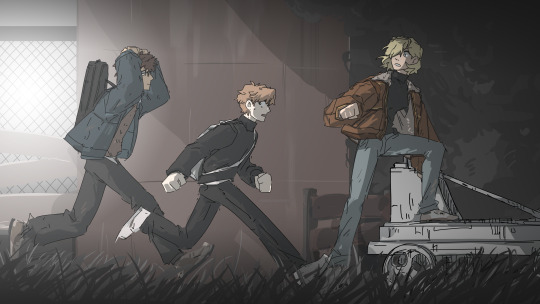
A web of alliances, insiders, clients, and territorial disputes - this is what forms the stalker business, a domain that’s as illegal as it is profitable.
Today, we’ll delve into the basic origins and inner workings of this peculiar profession. Let’s find out how these glorified marauders operate!
How did the stalker business develop?
The stalker business emerged almost as soon as the Zone itself was born. But, much like every structure based around the Zone itself, it became more refined - and more corrupt - as years went on.
What started as individuals travelling the Zone completely on their own accord grew into a network of organised groups with their own informants, clientele and designated territories. Yet when it looked like major alliances had become fully solidified with a couple of large groups operating across vast stretches of the Zone, the development of the internet put a dent in the system.
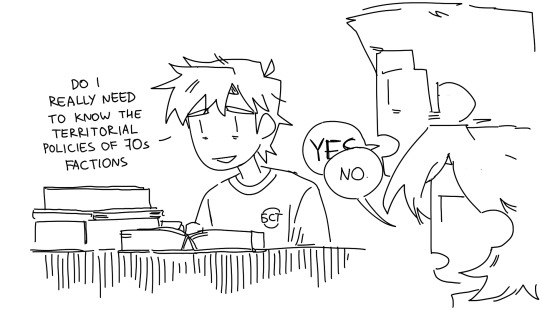
Yura: Do I really need to know the territorial policies of 70s factions Sergei: YES Olya: No.
As many information-gathering and order-related operations moved online, doing business in smaller groups became a more viable option. Nowadays, the majority choose to operate in gangs of up to 30 people.
Since the business has grown more decentralised and, in a way, accessible, the competition within it has increased dramatically. Territories are less clearly defined and run-ins with members of rivalling gangs are commonplace. When it comes to the human factor, it’s more dangerous than it ever was.
How are the little groups organised?
Modern stalker groups are typically formed around somebody who has direct connections to potential clients or those able to nicely aggregate information about the Zone’s current state. So any group needs at least one product reseller and one strategic leader, which can sometimes be the same person.
The latter is true for Sergei's group, for instance.
He is responsible for processing orders, evaluating the delivered artefacts, reselling them, gathering up to date information about the Zone’s landscape and traffic, and helping the available stalkers plan their trips accordingly. It’s a heavy workload, so having just one person performing all of those tasks wouldn’t be manageable on a larger scale.
Obviously enough, smaller groups are more reliant on the quality of their individual members, even more so when they have a specific role to fill. If we use known members of Sergei’s group as examples, they fit pretty neatly into the following roles:
Radar (радар). Formerly fulfilled by Kolya – a stalker with an outstanding sense for anomalies. Irreplaceable for navigating the more treacherous parts of the Zone. Yura was going to inherit that role.
Doctor (доктор). Self-explanatory. While it’s recommended that all stalkers undergo some form of first aid training, it never hurts to have someone with a deeper knowledge of medicine on the team. This role was filled by Nikita.
Insider (свояк). As the name suggests, it’s a person that helps in various aspects of stalker work by providing client contacts, guard post information, info about other gangs’ operations, and so on depending on their position. Insiders don’t usually take part in actual trips or even work with specific stalker groups, but Olya is built different.
Ram (таран). The muscle of the group. You don’t need to be especially physically fit to navigate the Zone,but when things become dire, it absolutely helps. This was Sergei’s role when he still travelled the Zone.
These are arbitrary designations and many don’t fit into one particular role. That said, creating a balanced group of 3 is easier when there’s a fair understanding of each person’s strengths.
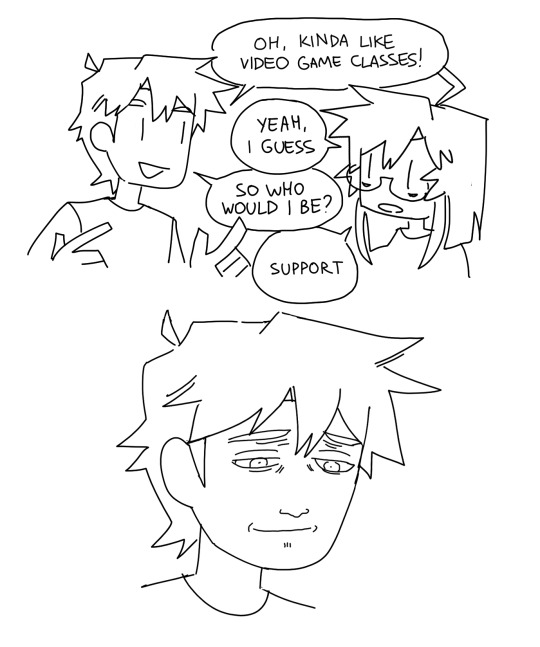
Yura: Oh, kinda like video game classes! Sanya: Yeah, I guess. Yura: So who would I be? Sanya: Support.
What does the typical work cycle look like?
An order is either placed on an online marketplace or is mailed directly to a trusted trader. The trader then passes the information to the strategist, who analyses the current Zone layout, as well as the latest available information about the placements of various artefacts and anomalies.
The strategist then determines the optimal routes to retrieving the ordered goods. Some use special software to aid in the process. The service price is then estimated based on the difficulty of retrieval and transportation. If the initial price suggested in the order is lower than this estimate, price negotiations will ensue.
Once the minimal price is agreed on, the actual planning starts. A group of three is gathered from the pool of available stalkers. They are all informed about the mission specifics and the route they need to travel - this is when the team can discuss and make adjustments to the plan.
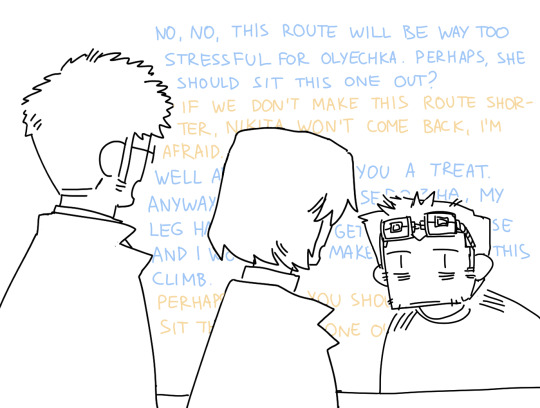
Nikita: No, no, this route will be way too stressful for Olyechka. Perhaps, she should sit this one out? Olya: If we don't make this route shorter, Nikita won't come back, I'm afraid. Nikita: Well, aren't you a treat. Anyways, Serozha, my leg has been getting worse and I won't make this climb. Olya: Perhaps, you should sit this one out.
After the artefacts are delivered to the trader, their quality is evaluated. Stalkers tend to pick up whatever valuables they find on the way, which means extra cash for them and more work for the trader.
Once the evaluation is complete, stalkers are paid off and the products are resold at a significantly higher price. The artefacts that were specifically ordered are exchanged for the agreed upon amount of money and the extra stuff is peddled to other high-paying customers.
Since selling artefacts is a risky and complicated endeavour in itself, most stalkers are content with the paychecks they get from their trader.
Finally, when everything is done, stalkers may anonymously share information about their trip to the online community. But considering the competitive nature of the business, not everyone is willing to help out their fellow colleagues – or really, not everyone wants to talk about the things they’ve seen.
What is the online stalker community like?
As was already mentioned, the internet has majorly changed how stalkers went about receiving orders and information about the Zone. It has become an important channel for communication and securing deals.
Firstly, all of the relevant platforms are on the deep web. Secondly, all of them are invite-only.
The three major platforms are:
Doska (literally “the board” as in bulletin board)
A marketplace where orders are placed and taken up by anyone interested, as well as an auction platform for selling off artefacts. Widely used by groups and stalkers who have not yet gained established clients.
Krematorii (crematorium)
A closed forum. Discussions, rumours, shitposting.

10K Crematorium karma
14KKM (as in 14 thousand kilometers, the approximate area of the Zone)
A dynamically updated map of the Zone. User-managed, hence chaotic and unreliable.
Users can mark locations of witnessed anomalies and artefact positions, which others can confirm or downvote. A marking needs to be confirmed by at least 4 people before it is put down and is removed if at least 4 people downvote it. All markings can be commented on.
Most of the community tries to maintain it more or less accurately for the sake of their own future missions, but there are malefactors that will add false markers to it. Should be taken with a huge grain of salt.
Of course, it bears mentioning that there are plenty of fake online communities on the surface web. Those are rife with people roleplaying as stalkers, scammers, kids, and just shitposters. No actual stalker uses those for business.
Rules regarding the Zone
Though the information side of things has changed a lot, the core methodology of travelling the Zone itself remained the same. Sets of universal rules became solidified over the years, which can be described as a mixture of operational protocols and esoteric beliefs.
What are the basic operational protocols?
Basic operational protocols outline best practices for dealing with simple anomalies, traversing the Zone, bypassing guard posts, and handling difficult situations (mercy kills, painless death, encountering other stalkers).
Some common recommendations include:
use projectiles (usually bolts with pieces of cloth attached for visibility) to check for gravitational anomalies;
operate in groups of three - two do the job, the third one watches on;
do not consume any food or drinks you find;
avoid unnatural shadows;
do not stay at the Hollow for over 20 minutes (your body will start to decay);
do not approach the Town (your body will permanently distort);
do not handle fizzy clay without rubber gloves (will leave you debilitated or addicted to the substance);
always send the draisine back;
don't photograph ghosts;
etc.
They are objective results of many years of trial and error. Going against them is likely to end in death or injury regardless of your personal qualities. In other words, there is little dispute over the validity of these rules. The same cannot be set for the second ruleset.
What are stalker beliefs?
The Zone favours the miserable. The desperate, the broken, the lonely. The Zone favours ones that are willing to give up their whole being to her, to completely entrust themselves to her whims. She rewards dejection.
These are common truths to some and hogwash to others. There is no solid proof for any of these claims - how can there be? However, there is no happy stalker, and there is no living stalker without a scar. To many, that's evidence enough.
On top of that, there are some group-specific philosophies. They include:
the Zone is a holy place that needs to be revered;
the Zone is an ulcer of the world that needs to be cleansed;
the Zone is the new stage of Earth’s evolution;
the Zone is divine punishment;
the Zone is a point of contact with a parallel universe;
and many others.
These philosophies dictate how people go about their activities in the Zone in a more ritualistic sense. It’s hard to devise whether or not those little rituals have any effect that isn’t purely psychological.
There is a good number of people that hold a purely cynical view of the Zone. But whether they admit it or not, everyone gradually develops a sense of fear and reverence for it. How they compartmentalise it is a different question.
Conclusion
I could write more about the topic, but as of now, I think this general outline should suffice. The stalker business is a multifaceted enterprise to say the least, so hopefully this article has shed the light on its most essential aspects.
Perhaps, there will one day be a more in-depth follow-up! Who knows. As we continue to unveil the enigmatic layers of the Zone, only time will reveal the full extent of its mysteries... And the engimatic layers of shitty Stalker forums, I guess.
563 notes
·
View notes
Text

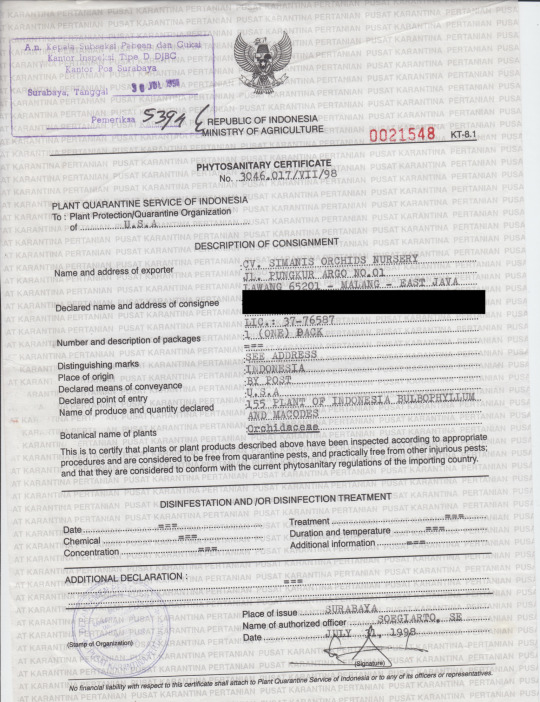
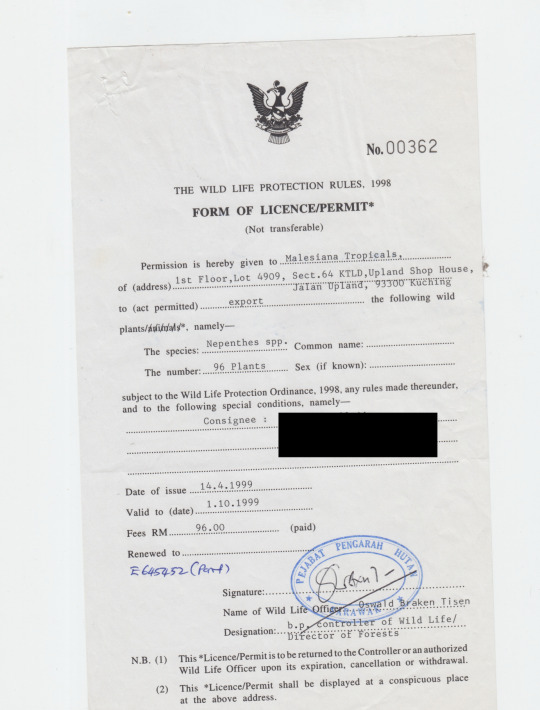

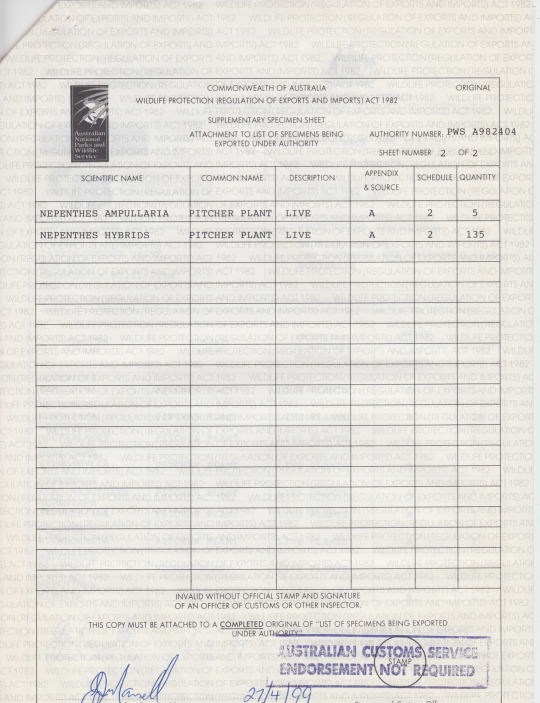
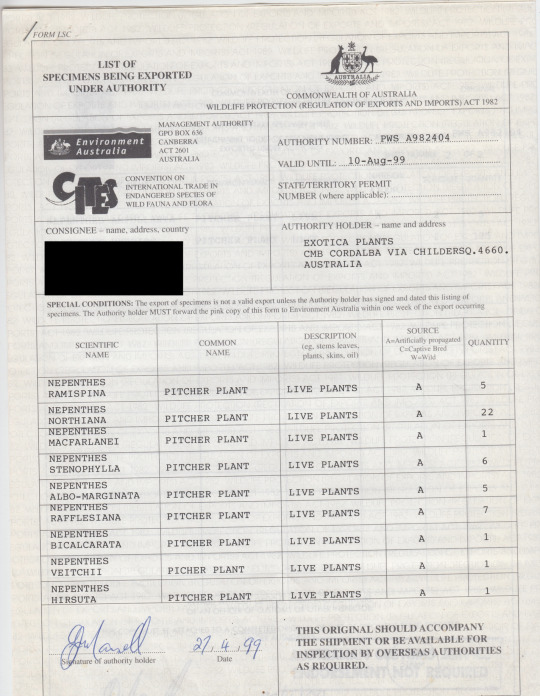
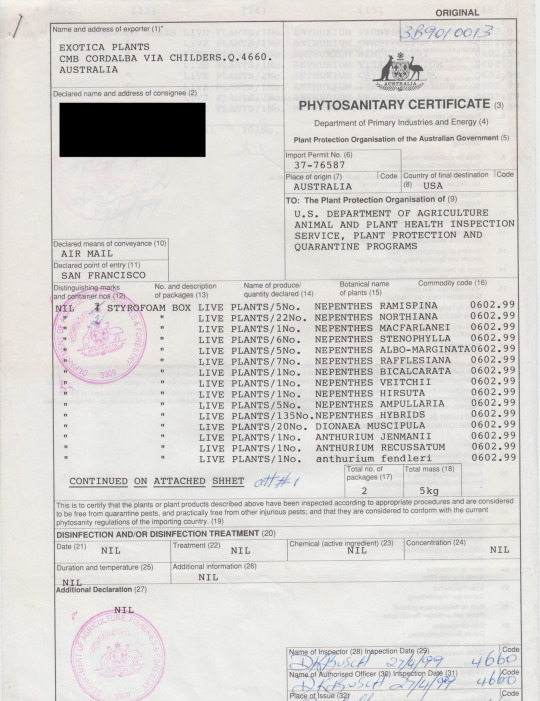
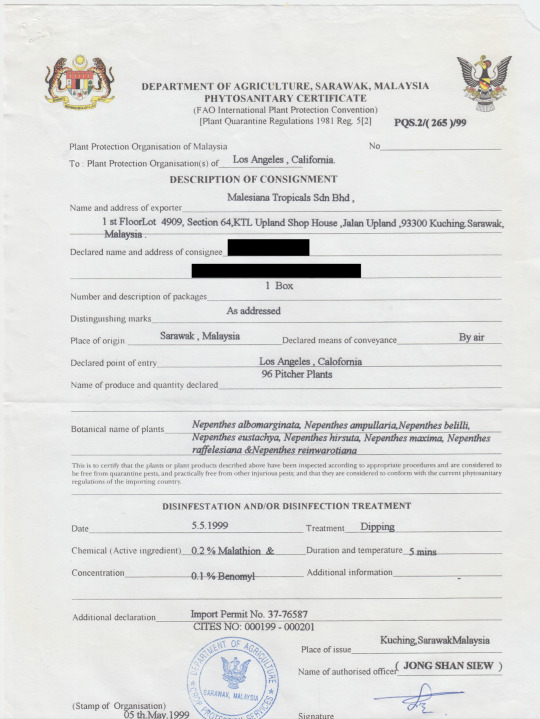
ok INCREDIBLY old content originally meant for this blog but in 2018 when i was just a wee lad with a little spinner propeller hat and big rainbow lollipop i went to a carnivorous plant convention in california and met a bunch of people who breed/collect/study these guys. one person was this collector who was slowly working on leaving the hobby or at least no longer growing plants, and he had a bunch of carnivorous plant related files he was charging like 50 cents for or something, and so i came into possession of these, which are examples of the kind of paperwork you have to have done to legally ship/trade endangered species of both plants and animals. functionally very boring paperwork, but something i found like, incredibly fascinating. i blacked out the personal id of the person and then immediately forgot to ever upload them, lmao.
these plants were bred and raised in a greenhouse and sold abroad, not taken from the wild, but because the species are endangered and often protected in their native countries (most of these are nepenthes, asian pitcher plants, a huge family spread throughout oceania and southeast asia), there's a lot more documentation that needs to be done regardless of their origin, both on the end of the seller and on the end of the buyer.
the rabbit hole on carnivorous plant trade is deep and kind of wild. there's plenty of common, non-threatened, greenhouse-grown pitcher plants on the market that people buy all the time, even non-collectors, but there's a whole debate to be had on if it's morally okay to be collecting the more endangered/rare of these plants in the first place. the big argument for breeding is that breeding them in captivity means there's more supply that's not poached from the wild, meaning poachers have less of an incentive to take the risk of taking adult plants from their habitats; from what i've heard, sometimes countries will issue permits for breeders to collect some wild seeds just to create a non-wild breeding pool to drive down the price. predictably, however, you also get people who are very much willing to pay a lot of money to get as rare of a plant as possible.
anyone familiar with the allure valuable plants have had over people throughout history can imagine the rest, but here's an article about a guy who started buying poached plants to enrich his private nepenthes collection, who then got busted by a fish and wildlife service agent embedded in his carvirorous plant circle. the plants this guy was buying were being sold to him without any CITES paperwork or declarations like the ones above; it was literally just a guy in indonesia taking rare plants from the woods around where he lived, selling them over facebook marketplace and ebay, and mailing them overseas as an undeclared 'gift' to get around customs. frighteningly small steps to take on all sides, to be honest.
(also, fun fact: another example of carnivorous plants that get poached are wild venus fly traps, which are only native to north and south carolina in the US. from what i understand it's a mix of people who genuinely did not know it's a native species and people who really are just going out into the woods and digging up plants to sell online. sometimes poaching is closer to home than you'd think!)
anyway. wild and interesting times in the land of plants recovered from a hard drive lmao
#nepenthes#annual 'plant poaching happens and it doesnt always look like the movies' post i suppose but also i think its really interesting#also the CITES system could do with an overhaul in how it approaches plants as well from what i understand but thats another thing#ive heard that like many systems like this they do not have the same urgency for plants as they do for animals#mostly because people just!! they dont get plants man!! they just say whatever its a plant!!#and poaching in general is only ever talked about like its with taking elephants for their tusks and stuff#also important conservation work but sometimes poaching really is just a guy with a shovel and that shit is WILD#carnivorous plants
525 notes
·
View notes
Text
ONİONSİTES - DRAGON+ (2)

Onion sites, also known as.onion sites, are a unique type of website that can only be accessed through the Tor network. The Tor network, short for The Onion Router, provides a layer of anonymity and encryption for users accessing these sites, making them popular for those seeking privacy and security online. Unlike traditional websites that can be accessed through standard web browsers, onion sites list require special software, such as the Tor browser, to navigate. Individuals can create onion versions of regular websites or develop standalone onion sites for specific purposes. The exclusivity and privacy features of onion sites contribute to their appeal for various users, ranging from privacy advocates to individuals navigating the dark web for specific content.
There are several reasons why individuals choose to use onion sites, with privacy and anonymity being at the forefront. Onion sites offer a level of confidentiality that is not typically found on the surface web, making them attractive to individuals seeking to protect their identity and browsing habits. Moreover, best onion sites can provide access to content that may be restricted or censored in certain regions, allowing users to circumvent such limitations and access information freely. The encrypted nature of the Tor network adds an additional layer of security, reducing the risk of surveillance and tracking by third parties, including governments and internet service providers.
Common types of content found on onion sites range from forums and marketplaces to news outlets and secure communication platforms. While exploring onion sites, individuals may come across forums, chat rooms, file-sharing platforms, and other interactive spaces that facilitate communication and information exchange in a secure environment. The anonymity and encryption offered 2024 onion sites contribute to a unique online experience, enabling users to engage with content and communities that may not be easily accessible through conventional web browsers.
1K notes
·
View notes
Text
The Metaverse: A New Frontier in Digital Interaction

The concept of the metaverse has captivated the imagination of technologists, futurists, and businesses alike. Envisioned as a collective virtual shared space, the metaverse merges physical and digital realities, offering immersive experiences and unprecedented opportunities for interaction, commerce, and creativity. This article delves into the metaverse, its potential impact on various sectors, the technologies driving its development, and notable projects shaping this emerging landscape.
What is the Metaverse?
The metaverse is a digital universe that encompasses virtual and augmented reality, providing a persistent, shared, and interactive online environment. In the metaverse, users can create avatars, interact with others, attend virtual events, own virtual property, and engage in economic activities. Unlike traditional online experiences, the metaverse aims to replicate and enhance the real world, offering seamless integration of the physical and digital realms.
Key Components of the Metaverse
Virtual Worlds: Virtual worlds are digital environments where users can explore, interact, and create. Platforms like Decentraland, Sandbox, and VRChat offer expansive virtual spaces where users can build, socialize, and participate in various activities.
Augmented Reality (AR): AR overlays digital information onto the real world, enhancing user experiences through devices like smartphones and AR glasses. Examples include Pokémon GO and AR navigation apps that blend digital content with physical surroundings.
Virtual Reality (VR): VR provides immersive experiences through headsets that transport users to fully digital environments. Companies like Oculus, HTC Vive, and Sony PlayStation VR are leading the way in developing advanced VR hardware and software.
Blockchain Technology: Blockchain plays a crucial role in the metaverse by enabling decentralized ownership, digital scarcity, and secure transactions. NFTs (Non-Fungible Tokens) and cryptocurrencies are integral to the metaverse economy, allowing users to buy, sell, and trade virtual assets.
Digital Economy: The metaverse features a robust digital economy where users can earn, spend, and invest in virtual goods and services. Virtual real estate, digital art, and in-game items are examples of assets that hold real-world value within the metaverse.
Potential Impact of the Metaverse
Social Interaction: The metaverse offers new ways for people to connect and interact, transcending geographical boundaries. Virtual events, social spaces, and collaborative environments provide opportunities for meaningful engagement and community building.
Entertainment and Gaming: The entertainment and gaming industries are poised to benefit significantly from the metaverse. Immersive games, virtual concerts, and interactive storytelling experiences offer new dimensions of engagement and creativity.
Education and Training: The metaverse has the potential to revolutionize education and training by providing immersive, interactive learning environments. Virtual classrooms, simulations, and collaborative projects can enhance educational outcomes and accessibility.
Commerce and Retail: Virtual shopping experiences and digital marketplaces enable businesses to reach global audiences in innovative ways. Brands can create virtual storefronts, offer unique digital products, and engage customers through immersive experiences.
Work and Collaboration: The metaverse can transform the future of work by providing virtual offices, meeting spaces, and collaborative tools. Remote work and global collaboration become more seamless and engaging in a fully digital environment.
Technologies Driving the Metaverse
5G Connectivity: High-speed, low-latency 5G networks are essential for delivering seamless and responsive metaverse experiences. Enhanced connectivity enables real-time interactions and high-quality streaming of immersive content.
Advanced Graphics and Computing: Powerful graphics processing units (GPUs) and cloud computing resources are crucial for rendering detailed virtual environments and supporting large-scale metaverse platforms.
Artificial Intelligence (AI): AI enhances the metaverse by enabling realistic avatars, intelligent virtual assistants, and dynamic content generation. AI-driven algorithms can personalize experiences and optimize virtual interactions.
Wearable Technology: Wearable devices, such as VR headsets, AR glasses, and haptic feedback suits, provide users with immersive and interactive experiences. Advancements in wearable technology are critical for enhancing the metaverse experience.
Notable Metaverse Projects
Decentraland: Decentraland is a decentralized virtual world where users can buy, sell, and develop virtual real estate as NFTs. The platform offers a wide range of experiences, from gaming and socializing to virtual commerce and education.
Sandbox: Sandbox is a virtual world that allows users to create, own, and monetize their gaming experiences using blockchain technology. The platform's user-generated content and virtual real estate model have attracted a vibrant community of creators and players.
Facebook's Meta: Facebook's rebranding to Meta underscores its commitment to building the metaverse. Meta aims to create interconnected virtual spaces for social interaction, work, and entertainment, leveraging its existing social media infrastructure.
Roblox: Roblox is an online platform that enables users to create and play games developed by other users. With its extensive user-generated content and virtual economy, Roblox exemplifies the potential of the metaverse in gaming and social interaction.
Sexy Meme Coin (SEXXXY): Sexy Meme Coin integrates metaverse elements by offering a decentralized marketplace for buying, selling, and trading memes as NFTs. This unique approach combines humor, creativity, and digital ownership, adding a distinct flavor to the metaverse landscape. Learn more about Sexy Meme Coin at Sexy Meme Coin.
The Future of the Metaverse
The metaverse is still in its early stages, but its potential to reshape digital interaction is immense. As technology advances and more industries explore its possibilities, the metaverse is likely to become an integral part of our daily lives. Collaboration between technology providers, content creators, and businesses will drive the development of the metaverse, creating new opportunities for innovation and growth.
Conclusion
The metaverse represents a new frontier in digital interaction, offering immersive and interconnected experiences that bridge the physical and digital worlds. With its potential to transform social interaction, entertainment, education, commerce, and work, the metaverse is poised to revolutionize various aspects of our lives. Notable projects like Decentraland, Sandbox, Meta, Roblox, and Sexy Meme Coin are at the forefront of this transformation, showcasing the diverse possibilities within this emerging digital universe.
For those interested in the playful and innovative side of the metaverse, Sexy Meme Coin offers a unique and entertaining platform. Visit Sexy Meme Coin to explore this exciting project and join the community.
261 notes
·
View notes
Text
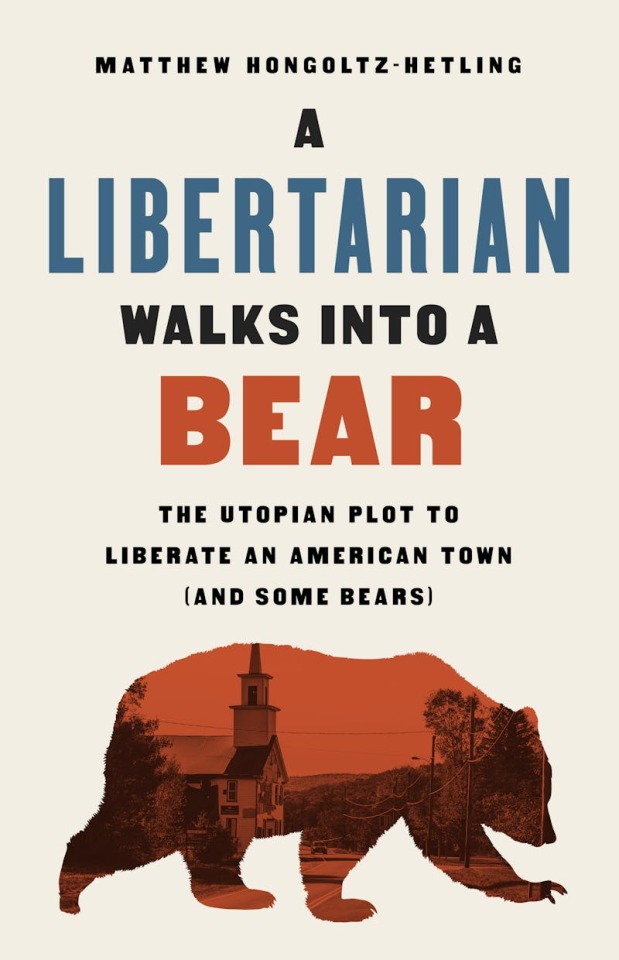
A Libertarian Walks Into a Bear: The Utopian Plot to Liberate an American Town (and Some Bears)
PublicAffairs, 288 pp., $28.00
But don’t worry—it almost never comes to this. As one park service PSA noted this summer, bears “usually just want to be left alone. Don’t we all?” In other words, if you encounter a black bear, try to look big, back slowly away, and trust in the creature’s inner libertarian. Unless, that is, the bear in question hails from certain wilds of western New Hampshire. Because, as Matthew Hongoltz-Hetling’s new book suggests, that unfortunate animal may have a far more aggressive disposition, and relate to libertarianism first and foremost as a flavor of human cuisine.
Hongoltz-Hetling is an accomplished journalist based in Vermont, a Pulitzer nominee and George Polk Award winner. A Libertarian Walks Into a Bear: The Utopian Plot to Liberate an American Town (and Some Bears) sees him traversing rural New England as he reconstructs a remarkable, and remarkably strange, episode in recent history. This is the so-called Free Town Project, a venture wherein a group of libertarian activists attempted to take over a tiny New Hampshire town, Grafton, and transform it into a haven for libertarian ideals—part social experiment, part beacon to the faithful, Galt’s Gulch meets the New Jerusalem. These people had found one another largely over the internet, posting manifestos and engaging in utopian daydreaming on online message boards. While their various platforms and bugbears were inevitably idiosyncratic, certain beliefs united them: that the radical freedom of markets and the marketplace of ideas was an unalloyed good; that “statism” in the form of government interference (above all, taxes) was irredeemably bad. Left alone, they believed, free individuals would thrive and self-regulate, thanks to the sheer force of “logic,” “reason,” and efficiency. For inspirations, they drew upon precedents from fiction (Ayn Rand loomed large) as well as from real life, most notably a series of micro-nation projects ventured in the Pacific and Caribbean during the 1970s and 1980s.
None of those micro-nations, it should be observed, panned out, and things in New Hampshire don’t bode well either—especially when the humans collide with a newly brazen population of bears, themselves just “working to create their own utopia,” property lines and market logic be damned. The resulting narrative is simultaneously hilarious, poignant, and deeply unsettling. Sigmund Freud once described the value of civilization, with all its “discontents,” as a compromise product, the best that can be expected from mitigating human vulnerability to “indifferent nature” on one hand and our vulnerability to one another on the other. Hongoltz-Hetling presents, in microcosm, a case study in how a politics that fetishizes the pursuit of “freedom,” both individual and economic, is in fact a recipe for impoverishment and supercharged vulnerability on both fronts at once. In a United States wracked by virus, mounting climate change, and ruthless corporate pillaging and governmental deregulation, the lessons from one tiny New Hampshire town are stark indeed.
“In a country known for fussy states with streaks of independence,” Hongoltz-Hetling observes, “New Hampshire is among the fussiest and the streakiest.” New Hampshire is, after all, the Live Free or Die state, imposing neither an income nor a sales tax, and boasting, among other things, the highest per capita rate of machine gun ownership. In the case of Grafton, the history of Living Free—so to speak—has deep roots. The town’s Colonial-era settlers started out by ignoring “centuries of traditional Abenaki law by purchasing land from founding father John Hancock and other speculators.” Next, they ran off Royalist law enforcement, come to collect lumber for the king, and soon discovered their most enduring pursuit: the avoidance of taxes. As early as 1777, Grafton’s citizens were asking their government to be spared taxes and, when they were not, just stopped paying them.
Nearly two and a half centuries later, Grafton has become something of a magnet for seekers and quirky types, from adherents of the Unification Church of the Reverend Sun Myung Moon to hippie burnouts and more. Particularly important for the story is one John Babiarz, a software designer with a Krusty the Klown laugh, who decamped from Big-Government-Friendly Connecticut in the 1990s to homestead in New Hampshire with his equally freedom-loving wife, Rosalie. Entering a sylvan world that was, Hongoltz-Hetling writes, “almost as if they had driven through a time warp and into New England’s revolutionary days, when freedom outweighed fealty and trees outnumbered taxes,” the two built a new life for themselves, with John eventually coming to head Grafton’s volunteer fire department (which he describes as a “mutual aid” venture) and running for governor on the libertarian ticket.
Although John’s bids for high office failed, his ambitions remained undimmed, and in 2004 he and Rosalie connected with a small group of libertarian activists. Might not Grafton, with its lack of zoning laws and low levels of civic participation, be the perfect place to create an intentional community based on Logic and Free Market Principles? After all, in a town with fewer than 800 registered voters, and plenty of property for sale, it would not take much for a committed group of transplants to establish a foothold, and then win dominance of municipal governance. And so the Free Town Project began. The libertarians expected to be greeted as liberators, but from the first town meeting, they faced the inconvenient reality that many of Grafton’s presumably freedom-loving citizens saw them as outsiders first, and compatriots second—if at all. Tensions flared further when a little Googling revealed what “freedom” entailed for some of the new colonists. One of the original masterminds of the plan, a certain Larry Pendarvis, had written of his intention to create a space honoring the freedom to “traffic organs, the right to hold duels, and the God-given, underappreciated right to organize so-called bum fights.” He had also bemoaned the persecution of the “victimless crime” that is “consensual cannibalism.” (“Logic is a strange thing,” observes Hongoltz-Hetling.)
While Pendarvis eventually had to take his mail-order Filipina bride business and dreams of municipal takeovers elsewhere (read: Texas), his comrades in the Free Town Project remained undeterred. Soon, they convinced themselves that, evidence and reactions to Pendarvis notwithstanding, the Project must actually enjoy the support of a silent majority of freedom-loving Graftonites. How could it not? This was Freedom, after all. And so the libertarians keep coming, even as Babiarz himself soon came to rue the fact that “the libertarians were operating under vampire rules—the invitation to enter, once offered, could not be rescinded.” The precise numbers are hard to pin down, but ultimately the town’s population of a little more than 1,100 swelled with 200 new residents, overwhelmingly men, with very strong opinions and plenty of guns.
Hongoltz-Hetling profiles many newcomers, all of them larger-than-life, yet quite real. The people who joined the Free Town Project in its first five years were, as he describes, “free radicals”—men with “either too much money or not enough,” with either capital to burn or nothing to lose. There’s John Connell of Massachusetts, who arrived on a mission from God, liquidated his savings, and bought the historic Grafton Center Meetinghouse, transforming it into the “Peaceful Assembly Church,” an endeavor that mixed garish folk art, strange rants from its new pastor (Connell himself), and a quixotic quest to secure tax exemption while refusing to acknowledge the legitimacy of the IRS to grant it. There’s Adam Franz, a self-described anti-capitalist who set up a tent city to serve as “a planned community of survivalists,” even though no one who joined it had any real bushcraft skills. There’s Richard Angell, an anti-circumcision activist known as “Dick Angel.” And so on. As Hongoltz-Hetling makes clear, libertarianism can indeed have a certain big-tent character, especially when the scene is a new landscape of freedom-lovers making “homes out of yurts and RVs, trailers and tents, geodesic domes and shipping containers.”
If the Libertarian vision of Freedom can take many shapes and sizes, one thing is bedrock: “Busybodies” and “statists” need to stay out of the way. And so the Free Towners spent years pursuing an aggressive program of governmental takeover and delegitimation, their appetite for litigation matched only by their enthusiasm for cutting public services. They slashed the town’s already tiny yearly budget of $1 million by 30 percent, obliged the town to fight legal test case after test case, and staged absurd, standoffish encounters with the sheriff to rack up YouTube hits. Grafton was a poor town to begin with, but with tax revenue dropping even as its population expanded, things got steadily worse. Potholes multiplied, domestic disputes proliferated, violent crime spiked, and town workers started going without heat. “Despite several promising efforts,” Hongoltz-Hetling dryly notes, “a robust Randian private sector failed to emerge to replace public services.” Instead, Grafton, “a haven for miserable people,” became a town gone “feral.” Enter the bears, stage right.
Black bears, it should be stressed, are generally a pretty chill bunch. The woods of North America are home to some three-quarters of a million of them; on average, there is at most one human fatality from a black bear attack per year, even as bears and humans increasingly come into contact in expanding suburbs and on hiking trails. But tracking headlines on human-bear encounters in New England in his capacity as a regional journalist in the 2000s, Hongoltz-Hetling noticed something distressing: The black bears in Grafton were not like other black bears. Singularly “bold,” they started hanging out in yards and on patios in broad daylight. Most bears avoid loud noises; these casually ignored the efforts of Graftonites to run them off. Chickens and sheep began to disappear at alarming rates. Household pets went missing, too. One Graftonite was playing with her kittens on her lawn when a bear bounded out of the woods, grabbed two of them, and scarfed them down. Soon enough, the bears were hanging out on porches and trying to enter homes.
Combining wry description with evocative bits of scientific fact, Hongoltz-Hetling’s portrayal of the bears moves from comical if foreboding to downright terrifying. These are animals that can scent food seven times farther than a trained bloodhound, that can flip 300-pound stones with ease, and that can, when necessary, run in bursts of speed rivaling a deer’s. When the bears finally start mauling humans—attacking two women in their homes—Hongoltz-Hetling’s relation of the scenes is nightmarish. “If you look at their eyes, you understand,” one survivor tells him, “that they are completely alien to us.”
What was the deal with Grafton’s bears? Hongoltz-Hetling investigates the question at length, probing numerous hypotheses for why the creatures have become so uncharacteristically aggressive, indifferent, intelligent, and unafraid. Is it the lack of zoning, the resulting incursion into bear habitats, and the reluctance of Graftonites to pay for, let alone mandate, bear-proof garbage bins? Might the bears be deranged somehow, perhaps even disinhibited and emboldened by toxoplasmosis infections, picked up from eating trash and pet waste from said unsecured bins? There can be no definitive answer to these questions, but one thing is clear: The libertarian social experiment underway in Grafton was uniquely incapable of dealing with the problem. “Free Towners were finding that the situations that had been so easy to problem-solve in the abstract medium of message boards were difficult to resolve in person.”
Grappling with what to do about the bears, the Graftonites also wrestled with the arguments of certain libertarians who questioned whether they should do anything at all—especially since several of the town residents had taken to feeding the bears, more or less just because they could. One woman, who prudently chose to remain anonymous save for the sobriquet “Doughnut Lady,” revealed to Hongoltz-Hetling that she had taken to welcoming bears on her property for regular feasts of grain topped with sugared doughnuts. If those same bears showed up on someone else’s lawn expecting similar treatment, that wasn’t her problem. The bears, for their part, were left to navigate the mixed messages sent by humans who alternately threw firecrackers and pastries at them. Such are the paradoxes of Freedom. Some people just “don’t get the responsibility side of being libertarians,” Rosalie Babiarz tells Hongoltz-Hetling, which is certainly one way of framing the problem.
Pressed by bears from without and internecine conflicts from within, the Free Town Project began to come apart. Caught up in “pitched battles over who was living free, but free in the right way,” the libertarians descended into accusing one another of statism, leaving individuals and groups to do the best (or worst) they could. Some kept feeding the bears, some built traps, others holed up in their homes, and still others went everywhere toting increasingly larger-caliber handguns. After one particularly vicious attack, a shadowy posse formed and shot more than a dozen bears in their dens. This effort, which was thoroughly illegal, merely put a dent in the population; soon enough, the bears were back in force.
Meanwhile, the dreams of numerous libertarians came to ends variously dramatic and quiet. A real estate development venture known as Grafton Gulch, in homage to the dissident enclave in Ayn Rand’s Atlas Shrugged, went belly-up. After losing a last-ditch effort to secure tax exemption, a financially ruined Connell found himself unable to keep the heat on at the Meetinghouse; in the midst of a brutal winter, he waxed apocalyptic and then died in a fire. Franz quit his survivalist commune, which soon walled itself off into a prisonlike compound, the better to enjoy freedom. And John Babiarz, the erstwhile inaugurator of the Project, became the target of relentless vilification by his former ideological cohorts, who did not appreciate his refusal to let them enjoy unsecured blazes on high-wildfire–risk afternoons. When another, higher-profile libertarian social engineering enterprise, the Free State Project, received national attention by promoting a mass influx to New Hampshire in general (as opposed to just Grafton), the Free Town Project’s fate was sealed. Grafton became “just another town in a state with many options,” options that did not have the same problem with bears.
Or at least—not yet. Statewide, a perverse synergy between conservationist and austerity impulses in New Hampshire governance has translated into an approach to “bear management” policy that could accurately be described as laissez-faire. When Graftonites sought help from New Hampshire Fish and Game officials, they received little more than reminders that killing bears without a license is illegal, and plenty of highly dubious victim-blaming to boot. Had not the woman savaged by a bear been cooking a pot roast at the time? No? Well, nevertheless. Even when the state has tried to rein in the population with culls, it has been too late. Between 1998 and 2013, the number of bears doubled in the wildlife management region that includes Grafton. “Something’s Bruin in New Hampshire—Learn to Live with Bears,” the state’s literature advises.
The bear problem, in other words, is much bigger than individual libertarian cranks refusing to secure their garbage. It is a problem born of years of neglect and mismanagement by legislators, and, arguably, indifference from New Hampshire taxpayers in general, who have proved reluctant to step up and allocate resources to Fish and Game, even as the agency’s traditional source of funding—income from hunting licenses—has dwindled. Exceptions like Doughnut Lady aside, no one wants bears in their backyard, but apparently no one wants to invest sustainably in institutions doing the unglamorous work to keep them out either. Whether such indifference and complacency gets laundered into rhetoric of fiscal prudence, half-baked environmentalism, or individual responsibility, the end result is the same: The bears abide—and multiply.
Their prosperity also appears to be linked to man-made disasters that have played out on a national and global scale—patterns of unsustainable construction and land use, and the climate crisis. More than once, Hongoltz-Hetling flags the fact that upticks in bear activity unfold alongside apparently ever more frequent droughts. Drier summers may well be robbing bears of traditional plant and animal sources of food, even as hotter winters are disrupting or even ending their capacity to hibernate. Meanwhile, human garbage, replete with high-calorie artificial ingredients, piles up, offering especially enticing treats, even in the dead of winter—particularly in places with zoning and waste management practices as chaotic as those in Grafton, but also in areas where suburban sprawl is reaching farther into the habitats of wild animals. The result may be a new kind of bear, one “torn between the unique dangers and caloric payloads that humans provide—they are more sleep-deprived, more anxious, more desperate, and more twitchy than the bear that nature produced.” Ever-hungry for new frontiers in personal autonomy and market emancipation, human beings have altered the environment with the unintended result of empowering newly ravenous bears to boot.
Ignoring institutional failure and mounting crises does not make them go away. But some may take refuge in confidence that, when the metaphorical chickens (or, rather, bears) finally come home to roost, the effects are never felt equally. When bears show up in higher-income communities like Hanover (home to Dartmouth College), Hongoltz-Hetling notes, they get parody Twitter accounts and are promptly evacuated to wildernesses in the north; poorer rural locales are left to fend for themselves, and the residents blamed for doing what they can. In other words, the “unintended natural selection of the bears that are trying to survive alongside modern humans” is unfolding along with competition among human beings amid failing infrastructure and scarce resources, a struggle with Social Darwinist dynamics of its own.
The distinction between a municipality of eccentric libertarians and a state whose response to crisis is, in so many words, “Learn to Live With It” may well be a matter of degree rather than kind. Whether it be assaults by bears, imperceptible toxoplasmosis parasites, or a way of life where the freedom of markets ultimately trumps individual freedom, even the most cocksure of Grafton’s inhabitants must inevitably face something beyond and bigger than them. In that, they are hardly alone. Clearly, when it comes to certain kinds of problems, the response must be collective, supported by public effort, and dominated by something other than too-tidy-by-half invocations of market rationality and the maximization of individual personal freedom. If not, well, then we had all best get some practice in learning when and how to play dead, and hope for the best.
114 notes
·
View notes
Text
idk man, online fandom is just not the place for me.
"reblog my art/writing!!!11" "I'll block people who only like my stuff but don't reblog"
this is so intense. I have zero interest in talking to people who are trying to bully me into promoting them. It's as if people are saying:
"If you don't comment on people's fanwork, fandom will die because of you, specifically"
I get it, attention is nice. I'm a creator too. And it's true that current social media isn't conducive of creating and maintaining communities. But you don't build a community with aggression against your own audience.
I don't wanna hang out with people who yell at me about how they don't get enough attention. You're blaming the audience when the real problem goes way, way deeper, and this behavior of prioritizing content promotion over actual human connection is actually part of the issue. Urging people to reblog your stuff may grant you exposure, but it sure doesn't make you any friendships, at least not mine.
-
A few years back, I wanted to refine my comedic writing and started a whacky Fallout 4 blog long after the fandom had seen its peak. I knew there wouldn't be a large audience, but I wanted to see what would happen. Long story short, I regularly invited my followers to send asks I would answer in-character, and honestly had so much fun. I never bullied my audience for only liking and not reblogging. To the contrary; I respect my audience and their prerogative to decide for themselves what they do want to share on their blogs and what they don't. It's *their* blogs. I cannot grasp the audacity of some creators to demand space on people's personal blogs. I really can't.
I only had the Fallout blog for like 8 months and got more audience attention than I could deal with at times. I had such a blast, getting asks, replying to them, building in-jokes with my followers. I ended the blog with a small event and was met with a flood of lovely comments and good-byes. Today, four years later, I post on that blog maybe one or two times a year. And even though most of my followers unfollowed me when I ended the blog, I still get the occasional lovely comment. After four years, people still remember the great time we had.
Good thing I didn't block all those wonderful people who mainly liked but didn't reblog. Word got around nonetheless. I found the audience I was looking for. Dunno if I would have had the same relaxed experience with a crowd who was bullied into the interaction.
-
idk, man. What is online fandom?
I don't like how we treat each other. Fandom is not a marketplace. I am not selling myself or my creations, I want to treat you better than a simple customer. At its heart, fandom is a gift economy. You don't owe me a thing. If you don't want to give freely, I won't take it with force. I respect you and myself too much for that.
I think we can still find our people in fandom, without exploiting our audience as market-criers.
55 notes
·
View notes
Text
QMarket | Online Marketplace Software For Entrepreneurs
Launch your Online business marketplace today with QMarket - An online marketplace builder. Also, try QMarket’s 30-day free trial and customize your online marketplace platform with unique features and flawless user experience.

#saas marketplace#online marketplace platform#marketplace for software#create a marketplace#online marketplace builder
0 notes